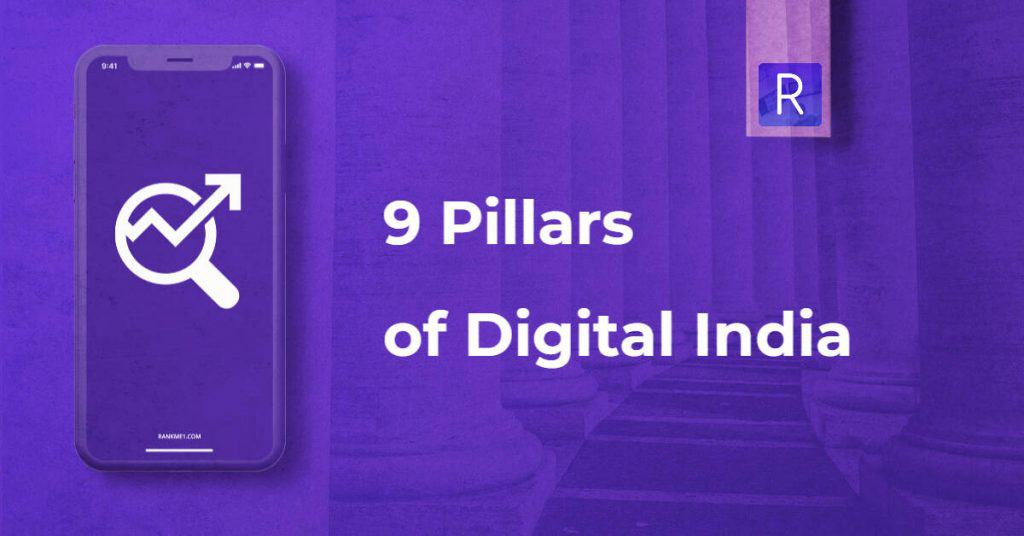Digital India is a campaign launched by the Government of India in order to ensure the Government’s services are made available to citizens electronically by improved online infrastructure and by increasing Internet connectivity or by making the country digitally empowered in the field of technology. The initiative includes plans to connect rural areas with high-speed internet networks. Digital India consists of three core components: the development of secure and stable digital infrastructure, delivering government services digitally, and universal digital literacy. To ensure that this happens, 9 pillars were introduced, the government focuses mainly in these nine things to make India digital. RankMe1 is One of the Best Digital Marketing Agency in Hyderabad , We Offer Results Oriented Search Engine Optimization, SEM, Social Media Marketing and Many More… Here are Objectives Of Digital Marketing & Here are our Hyderabad SEO Packages.
They are: –
• Broadband Highways
• Universal Access to Mobile Connectivity
• Public Internet Access Programme
• e-Governance: Reforming Government through Technology
• e-Kranti – Electronic Delivery of Services
• Information for All
• Electronics Manufacturing
• IT for Jobs
• Early Harvest Programmes
• Related Resources
Broadband Highways
• This covers three sub components, namely Broadband for All Rural, Broadband for All Urban and National Information Infrastructure.
• The aim of Broadband for All Rural is that 250 thousand village Panchayats should be covered by December, 2016. DoT will be the Nodal Department and the project cost is estimated to be approximately Rs. 32,000 Cr.
• Under Broadband for All Urban, Virtual Network Operators would be leveraged for service delivery and communication infrastructure in new urban development and buildings would be mandated.
• National Information Infrastructure would integrate the networks like SWAN, NKN and NOFN along with cloud enabled National and State Data Centers. It will also have provision for horizontal connectivity to 100, 50, 20 and 5 government offices/ service outlets at state, district, block and panchayat levels respectively. DeitY will be the nodal department and the project is estimated to cost around Rs 15,686 Cr for implementation in 2 years and maintenance & support for 5 years.
Universal Access to Mobile Connectivity
The initiative is to focus on network penetration and fill the gaps in connectivity in the country, and make sure that there is better network coverage in the country. All together 42,300 uncovered villages will be covered for providing universal mobile connectivity in the country. DoT will be the nodal department and project is estimated to cost Rs 16,000 Cr during FY 2014-18.
Public Internet Access Programme
The two main sub components of Public Internet Access Programme are Common Service Centers and Post Offices as multi-service centers.
Increase the number of Common Service from approximately 135,000 operational at present to 250,000 i.e. one CSC in each Gram Panchayat. CSCs would be made viable, multi-functional end-points for delivery of government and business services. DeitY would be the nodal department to implement the scheme.
A total of 150,000 Post Offices are proposed to be converted into multi service centers. Department of Posts would be the nodal department to implement this scheme.
e-Governance: Reforming Government through Technology
The guiding principles for reforming government through technology are:
Form simplification and field reduction – Forms should be made simple and easy to read and only minimum and necessary information should be collected.
Online applications, tracking of their status and interface between departments should be provided.
Use of online repositories like school certificates, voter ID cards, etc. should be made mandatory, so that citizens don’t have to submit these documents in physical form.
Integration of services and platforms, e.g. UIDAI, Payment Gateway, Mobile Platform, Electronic Data Interchange (EDI) etc. should be mandated to facilitate integrated and interoperable service delivery to citizens and businesses.
Electronic Databases – all databases and information should be electronic and not manual.
Workflow Automation Inside Government – The workflow inside government departments and agencies should be automated to enable efficient government processes and also to allow visibility of these processes to the citizens.
e-Kranti – Electronic Delivery of Services
There are 31 Mission Mode Projects under different stages of e-governance project lifecycle. Further, 10 new MMPs have been added to e-Kranti by the Apex Committee on National e-Governance Plan (NeGP) headed by the Cabinet Secretary in its meeting held on 18th March 2014. Some of the important modes are: –
Technology for Education – e-Education
Technology for Health – e-Healthcare
Technology for Security
Technology for Financial Inclusion
Technology for Justice
Technology for Planning
Technology for Cyber Security
Information for All
The focus will be on online internet website hosting service of data and realistic participation through social media and web-based systems like MyGov. The aim of this program is to provide easy access of information for citizens. Government shall pro-actively engage through social media and web-based platforms to inform citizens. MyGov.in has already been launched as a medium to exchange ideas/ suggestions with Government. It will make it easier for people to communicate with the government officials by launching a 2-way communication between citizens and government. Online messaging to citizens on special occasions/programs would be facilitated through emails and SMSes.
Electronics manufacturing
This focuses on VSAT, mobile, consumer electronics, technology, medical electronic devices, intelligent energy meters, Smart cards and micro ATMs. For this the government is coordinating on many fronts be it taxes, rewards, financial systems of range and offering cost benefits to local producers.
IT for Jobs
The government is planning on training one crore learners from small towns and villages for IT industry. Plans are also to exercise 300,000 assistance distribution providers in 2 years to run practical companies offering IT services and telecoms companies to train 500,000 rural workers in 5 years. BPOs would be set up in every north-eastern state to facilitate ICT enabled growth in these states. DeitY would be the nodal department for this scheme.Digital Marketing Analytics, SEO are Top in Demand.
Early Harvest
The government is planning to set up Aadhaar Allowed Fingerprint Presence Program in all central government workplaces situated at Delhi. A web-based application software system will allow online documenting of attendance and its watching by the involved stakeholders. A program of properly secured email is being recognized, to improve its utilization within government program for 50 lakh workers by March, 2015. To provide Wi-Fi in all colleges on NKN by Dec, 2015. All guides will be e-books and SMS based climate information and disaster alerts.
Wanna learn digital marketing? checkout free digital marketing course
Also Read: Top Art Magazines To Follow
RankMe1 > Digital Marketing Agency in Hyderabad


